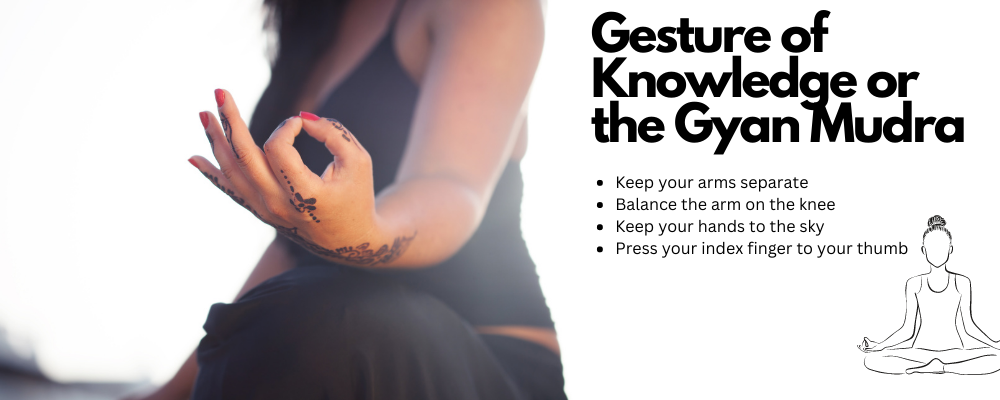Meditation hand positions drive beginners crazy because there’s always the question of, “where do I put my hands when meditating?” And then, you’ll see a world-class practitioner or a Buddha statue and notice they have very specific hand meditation positions.
In fact, there are a lot of hand positions with different meanings, but they’re called Mudras rather than hand positions.
Mudras are very specific gestures and they often have to do with two main things:
- Bringing your focus inward
- Channeling energy to specific parts of your body
If you’re practicing Kundalini meditation or Chakra meditation, meditation hand positions and meanings may help you control your energy flow.
However, some Mudras may involve the entire body rather than just the hands, so you’ll need to be mindful of this.
Fingers and the Elements They Represent in Meditation
Each of your fingers correlates to an element, and since Mudras are rooted in helping balance the elements, it’s important to know each finger’s elements. The elements for each finger, include:
- Thumb (Agni) – fire
- Index (Vayu) – air
- Middle Finger (Aakasha) – sky
- Ring (Prithvi) – earth
- Pinky (Jala) – water
While your hand and finger positions may seem subtle or insignificant to you, it is believed that they can help restore balance in the body.
8 Meditation Hand Positions and Meanings

1. Gesture of Knowledge or the Gyan Mudra
If you envision someone meditating and they’re holding their thumb and index finger together, you already know this Mudra. In fact, it’s the most popular of the bunch. It’s also one of the gestures that are often connected to the chin mudra.
In this pose, you’ll:
- Keep your arms separate
- Balance the arm on the knee, close to your elbow
- Keep your hands to the sky
- Press your index finger to your thumb
And, when you perform this Mudra, it will help sharpen your memory and is meant to bring you more spiritual knowledge, too.
2. Flowing Air or Vayu Mudra
If you have anxiety, stress, or pain, you can use the Vayu Mudra while meditating to help you hone in on these issues. The Mudra will help you begin regulating the air element in the body and can be performed by:
- Placing the tip of the index finger to the base of the thumb
- Keep the remaining fingers straight
3. Fearlessness or Abhaya Mudra
Fearlessness is something we can all work on, especially when there’s so much anxiety and uncertainty in the world. You can maintain this hand position whether you’re sitting or standing, and it involves placing an open palm to the front of you.
Envision someone putting their hand out to say, “stop,” this is how you’ll hold your hand.
The position will help:
- Ease fear
- Bring peace
- Raise protection
However, your right hand is the only one that is used. Raise the right hand to around your shoulder height and push your palm outwards and the fingers to the sky.
You can rest the left hand however you like.

4. Unshakeable Trust or Vajrapradama Mudra
The Mudra of unshakeable trust is a fun and common way to position your hands. If you feel like you need to be grounded, this is one of the best positions to try. It’s also very comfortable and has a way of calming the nervous system.
So, how do you master this hand position?
- Lace your fingers together
- Lift your laced hands to your heart
- Place the hands on the heart, palms facing the heart
You can perform your entire meditation using this hand position if you find it comfortable enough. After a long, difficult day, this Mudra can be quite calming.
5. Generosity or Varada Mudra
Generosity and kindness are part of this Mudra and it’s one of the positions that you’ll see Hindu statutes holding. Instead of focusing on yourself or correcting something in your life, this Mudra will be about giving and generosity.
However, it’s a little tricky to maintain this hand position without seeing it first.
The steps below may help:
- Place the back of the right wrist to your thigh
- Open the palm to the sky
- Stretch the fingers down to the ground
Your palm will be facing away from you in this pose as if pushing the generosity out of yourself. The left hand does not follow this Mudra, so you can choose one of the other ones on the list if you like.
6. Perception or Buddhi Mudra
Buddhi is one of the Mudras that are used most often and is associated with intellect and perception. The Mudra is meant to help you through your journey by improving:
- Clarity
- Mindfulness
- Understanding
If you’re seeking answers or wisdom, try using this meditation hand position. Your thumb should touch the tip of your pinky while you extend the rest of your three fingers outward. You’ll then want to rest the back of your hand on your knee or thigh when meditating so that your palms are facing the sky in this position.
You can also try placing your hands on the middle or upper thigh if that’s more comfortable for you.
7. Enlightenment or Dhyana Mudra
Searching for enlightenment is one of the incorrect reasons to first start your meditation, but it is something most people hope to achieve over time. Of course, you may never reach enlightenment, but you can still bring some extra enlightenment into your practice with the Dhyana Mudra.
You’ll find that this hand position will help you concentrate and focus.
And for many people, Dhyana Mudra will also bring a feeling of calmness and peace to them when they’re feeling stressed. Beginning this hand position is quite easy:
- Place both hands together on the lower abdomen
- Place your palms in the air
- Place the left hand under the right hand
- Touch the point of your thumbs together
If you’re following this right, the space between the thumbs will form somewhat of a triangle.
8. Earth Touching or Bhumisparsha Mudra
Buddhists will recognize this hand position because it is associated with the awakening of the Buddha. The symbolism of this Mudra is one of the most important because Buddha touches the earth so that it can be a witness of his enlightenment.
You can begin performing this Mudra by doing the following:
- Sit down for your meditation
- Place your left hand on your knee, facing the sky
- Place your right hand on your knee, facing the earth
The fingers on the right hand must be pointed toward the ground.
Now that you know various meditation hand positions and meanings, you can begin using them in your own practice. Try different hand positions for meditation and find one that you like. If a position is uncomfortable at first, practice it a few times to see if it gets better.
If you still don’t find the hand position comfortable, one like unshakeable trust is comfortable and easy to maintain.

